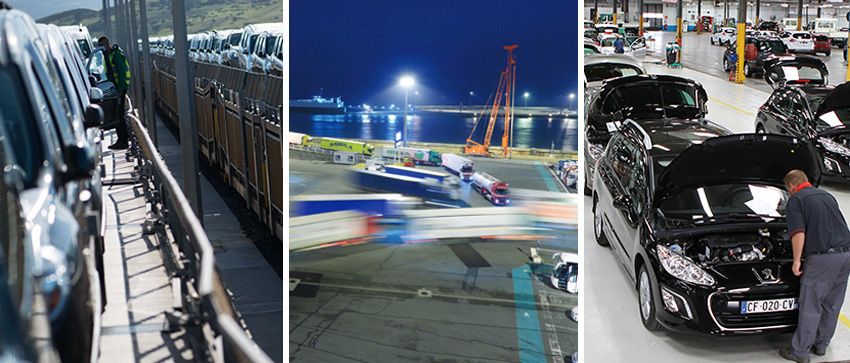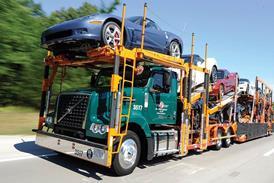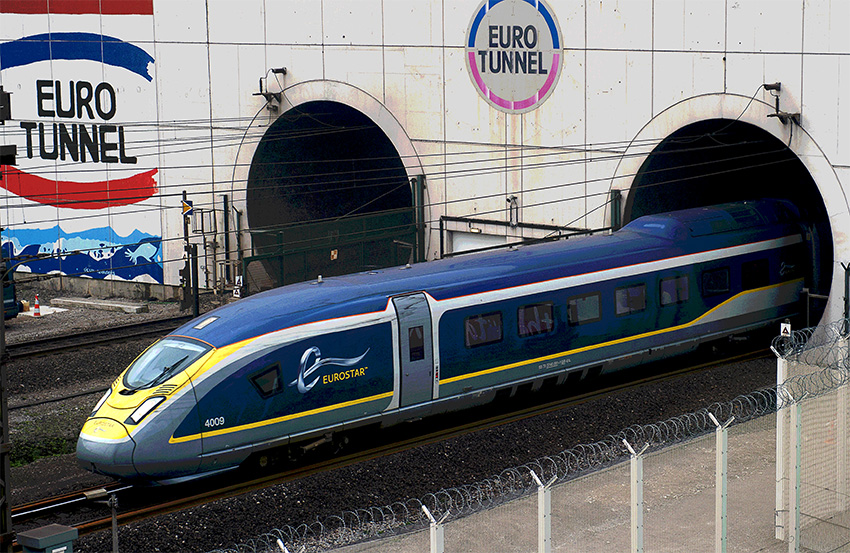Automotive Logistics reports on vehicle and component movements between the UK and the rest of Europe in the post-Brexit climate
The past year has brought freight movements between the UK and mainland Europe sharply into focus, including for automotive parts and finished vehicles. Britain’s vote to leave the European Union brought currency falls in the short term, and uncertainty over future trading conditions, including the degree to which the UK can retain barrier-free access to Europe’s Single Market while ending or significantly changing the free movement of labour across the EU to Britain.
Brexiteers had originally thought it unlikely that Europe’s car manufacturers and component suppliers would wish to see tariff walls erected against British automotive exports to the European Union, given the greater size of Europe’s vehicle exports to Britain. Yet that assumption no longer seems quite as secure, with Europe’s political leaders taking a hardline stance and many carmakers seemingly now resigned to tariffs. Several prominent figures at Germany’s business associations and its powerful automotive association, the VDA, have stressed the importance of European stability and unity over avoiding tariffs.
In this story...
Along with Brexit’s potential impact, trade flows between Britain and Europe were disrupted at various points in 2015 and 2016 as a result of transport strikes, as well as the camp of migrants and refugees in Calais wanting to reach the UK. From the camp, known as ‘The Jungle’, migrants attempted to board trucks, ferries and trains, often putting themselves and workers in danger, leading to congestion and closures of the key connectors between France and Britain. A number of manufacturers resorted to emergency freight measures to keep goods moving across the English Channel.
The Jungle was dismantled swiftly in October, but the problems may return and the situation has left a bad political taste; several candidates for France’s upcoming presidential elections have spoken about ending the Le Touquet treaty, which since 2003 has allowed people and goods to clear the UK border in France. If the border were to be moved back to the UK, significant traffic disruption would be likely, particularly in England’s south-east.
Both Brexit and the migrant crisis have highlighted the scale of reciprocal trade flows between Britain and continental Europe for the automotive industry and the modes of transport involved. This has reached the highest levels of government: after much media debate regarding the likely impact of the Brexit vote on Nissan’s decision over where to build the next-generation Qashqai and X-Trail models, its chairman, Carlos Ghosn, met with prime minister Theresa May in October. Two weeks later, Nissan announced the new vehicles would, after all, be built at its car plant in Sunderland, the UK’s single biggest vehicle assembly site, building around 500,000 cars per year.

Nissan, like other carmakers in the country, has a significant and complex supply chain inbound to the UK from mainland Europe. Informed sources say around 500 truckloads of parts a week pass through the port of Calais alone to support Sunderland and Renault Nissan’s business in the UK (though Nissan has declined to confirm this). And for every truck bringing in components, there are huge flows back in the form of finished vehicles, as Nissan exports around 55% of Sunderland’s output to mainland Europe.
At Jaguar Land Rover, meanwhile, an extensive continental European supply chain is operated by DHL, its lead logistics partner, which makes more than 1,000 collections from over 400 suppliers across the continent, with components delivered to UK crossdocks via consolidation crossdocks spread across Europe. JLR additionally exports around 25% of its UK production to the rest of the EU.
[sta_anchor id="1"]Overall, around 57% of exports from the UK’s carmakers go to the EU, according to the SMMT. The country also imports almost twice as many vehicles as it exports, with the EU the biggest source. The UK is furthermore a major engine producer, making 2.6m a year, many of which are also shipped to the EU. The UK is Ford’s largest global engine production centre, for instance, with UK-built engines shipped to every Ford plant in Europe.
Off the railsDespite high volumes of finished vehicles, powertrain products and components flowing both ways between the UK and mainland Europe, there is something curious about how that freight moves. In a country where the steam locomotive was invented and where the world’s first railway ran as long ago as 1830, a low proportion of this automotive freight moves by rail, especially considering the existence of the Channel Tunnel, a 31-mile (50km) rail link under the English Channel completed in 1994.
For example, the impressive flow of components from mainland Europe heading towards JLR is entirely road-based, with lorries crossing the Channel aboard ferries or dedicated ro-ro vessels between around 20 different ports in mainland Europe and a similar number in the UK. Furthermore, a number of major volume producers in the UK, including Nissan and Toyota, are entirely without railheads, although plans have been put forward to build a multi-user railhead just south of Toyota’s Burnaston, Derbyshire plant.
Lorries do move through the Channel Tunnel on rail freight shuttles operated by Eurotunnel, while DB Schenker also runs services. However, rail freight has been struggling of late and moving automotive freight purely by rail or in containers in intermodal operations seems rare.
 A very low proportion of automotive freight moves to and from the UK by rail
A very low proportion of automotive freight moves to and from the UK by railOutbound, rail is also a small-to-non-existent player for cross-Channel flows. JLR moves around 30% its UK vehicles by rail and recently worked with vehicle rail service provider STVA and UK national rail infrastructure company Network Rail to extend the length of its rail loading facilities and increase train sizes for finished vehicles. However, much of that traffic consists of vehicles from its Halewood and Castle Bromwich plants, heading for the deep-sea port of Southampton, from where most exports beyond Europe leave.
Likewise, STVA also operates trains carrying BMW’s Mini from Oxford to Southampton, and trains carrying Minis from Oxford to Purfleet, a port in the UK’s south-east which brings most of the vehicles to Europe, but neither JLR nor BMW uses the Channel Tunnel. Meanwhile, a purpose-built railhead at Honda’s Swindon plant, established in 2008 to send up to 23,000 vehicles a year through the Tunnel destined for a Honda distribution centre in Ghent, Belgium – and again operated by STVA – ceased operations a few years later. It restarted in the summer of 2016, reports STVA UK’s managing director Ian Brown, but only temporarily to meet a special requirement for around five weeks.
“The major carmakers tend to like rail as an option and value what it can do for their business in terms of efficiency and environmental performance,” Brown notes. “But in terms of rail traffic through the Channel Tunnel, they all have their established supply chains and established short-sea operations, and so rail tends to be used for short-term specific requests.”
Brown points out that the environmental and broader socio-economic benefits of rail freight are nevertheless persuasive. Philippa Edmunds, manager at Freight on Rail, a partnership between the rail freight industry, transport trade unions and the Campaign for Better Transport, argues that rail freight beats road across a wide range of metrics.
“Compared to the equivalent journey by road, rail freight produces 76% less carbon dioxide, 90% less PM10 particulate pollution, is 20 times safer than road in terms of fatal accidents, and the average freight train can carry the equivalent of 77 heavy trucks of freight,” she notes.
“At a time when government-produced figures estimate that a reduction in traffic of around 2% results in congestion falling by 10%, getting more freight onto the railways could significantly reduce congestion – especially on [road] corridors with high volumes of heavy trucks such as the M6, A14 and A34, where there are alternative parallel rail routes.”
[sta_anchor id="2"]So why does the automotive sector exhibit such a strong preference for road freight in cross-Channel flows? Industry insiders see barriers for rail ranging from the practical considerations of rolling stock to more fundamental questions as to whether the rail industry’s ways of working are suited to automotive’s lean and low-inventory principles.
Lead time and equipment constraints For one thing, says Antonio Fondevilla, executive vice-president and global automotive sector lead at Ceva Logistics, there’s an industry-wide perception that road freight is more flexible and reliable than rail freight in terms of meeting just-in-time replenishment requirements – even taking into account the chaos and slowdowns caused by the migrant crisis at Calais and various strikes at French channel ports.
Moreover, adds Frank Vorrath, vice-president of global supply chain at component manufacturer Johnson Controls, taking a network perspective and working backwards from the end customer requirement, rail is not always the best option from a lead time and inventory point of view. Such requirements are specified and set by the customer, and not the component supplier, whose hands are effectively tied.
“It’s all lead-time driven and you choose the mode of transport based on this – and it is the customer who specifies the lead time,” he says. “And typically, the requirements are so tightly specified and linked to manufacturing schedules at the assembly plants that rail just isn’t practical, from a lead time point of view.”
A similar view is shared by Andrew Baxter, managing director of international freight firm Europa Worldwide, which sees 75% of its revenues come from UK-EU trade. Europa moves loads from 36 European hubs to Dartford in the south-east, via the Channel Tunnel; it ships from 20 of those European hubs every night, and two or three times a week from the balance.
“To the market, rail seems to lack relevance,” he observes. “There are issues such as waiting for capacity to become available, which can introduce unexpected delays. Plus, timetabled transit times are usually longer than for road: this has been the case for over 20 years and it’s still the case today.”
Moreover, there is an argument that rail freight can work counter to the lean manufacturing principles that underpin many of today’s automotive operations.
“If a train rolls up at a plant, that’s quite a big breakbulk issue – whereas if a truck rolls up, it’s a smaller challenge,” observes industry expert Richard Gane, an ex-automotive manufacturing engineer, and director of procurement consultants Vendigital. “Plus, the truck can roll up right to the dock: by definition, a train unloading at a railhead will involve undertaking additional activities.”
Rolling stock also needs to be considered and here, there is a divide between much of mainland Europe and the UK. For example, European manufacturers generally prefer to use flexible-sided demountable swap bodies of a size that the UK’s rail network cannot accommodate on normal rolling stock, explains Maggie Simpson, executive director of the Rail Freight Group, a representative membership body that includes rail freight users, providers, terminal operators and logistics providers.
[sta_anchor id="3"]“European swap bodies can travel up [the UK’s high-speed ‘high speed one’ rail link] as far as Barking, just east of London, but can go no further because they will hit bridges and overhead platforms,” she notes. “Various pieces of work have looked at the concept of European swap bodies mounted on very low rail wagons, seeing where the obstacles are, and this line of enquiry is looking promising, but it’s very early days yet. Even so, using Barking as a crossdock will have a cost.”
 One reason for road's continued dominance is that it is perceived to be more flexible and reliable than rail freight, not least for just-in-time replenishment requirements
One reason for road's continued dominance is that it is perceived to be more flexible and reliable than rail freight, not least for just-in-time replenishment requirementsOutbound cost disadvantage There are some similar reasons why such limited use is made of the Channel Tunnel for vehicle logistics, as well as some entirely different factors.
Stuart Warren, managing director UK at logistics provider Groupe CAT, says the UK’s trade imbalance in finished vehicles means that shipping lines offer attractive rates on the return leg of routes from Europe. Combined with higher frequencies than might be the case with rail, this puts rail at an immediate pricing disadvantage.
Indeed, Warren adds, Groupe CAT and logistics provider Gefco formerly collaborated on a rail service to transport finished vehicles from Europe via the Channel Tunnel, to Gefco’s Corby inland distribution centre in the UK Midlands. However, the initiative was terminated when it was determined that it was more cost-effective to use ro-ro shipping lines going to ports closer to the final destination, rather than routing everything through the Channel Tunnel and Calais.
“The cost of the Channel Tunnel is just too high, compared to ro-ro,” sums up Warren.
Moreover, adds Rail Freight Group’s Simpson, any significant expansion of rail freight to ship finished vehicles would require investment in the UK’s rolling stock transporter fleet, in turn requiring a long-term commitment to use rail.
“The sense is that automotive manufacturers don’t do long-term contracts but it’s precisely those contracts that are required if such investments are to be made,” she points out. “We see such contracts in other sectors but not in automotive, meaning that there’s a risk in building transporter wagons, which acts as a barrier to an investment in fleet expansion.”
Meanwhile, say industry insiders, even with the present level of wagon usage, there are capacity constraints in certain types of transporter equipment, such as double-decker, fully enclosed wagons. These are preferred for some lanes because of their ability to protect the vehicles being transported from brake dust contamination, weather and occasional incidents of vandalism.
Allied to that question of fleet expansion and rail wagon capacity is the related topic of rail utilisation. Here, there are several issues. Stuart Warren points out some of the challenges associated with vehicle height as it relates to the contracts Groupe CAT is involved with: double-decker transporters can only transport cars, for instance, and not 4x4 vehicles or high SUVs. For these, a flatbed transporter wagon is required, and they are carried one-high, not two-high.
“It’s not just the number of rail wagons in circulation that’s a problem, it’s also their dimensions,” he concludes.
[sta_anchor id="4"]What’s more, adds Rail Freight Group’s Simpson, too many transporter wagons run empty as there aren’t enough return loads. “We see a lot of ports that only do inbound vehicles, and a lot of ports that only do outbound vehicles,” she explains. “What is needed is more ports that do both, to ease the utilisation and triangulation problems that are hitting rail freight usage at the moment.”
A brighter day ahead?A number of variables could impact future freight flows across the Channel. Of course, a ‘hard Brexit’ in which numerous tariffs are introduced across various freight, from automotive parts to vehicles to agriculture, would be likely to put a dent in current volumes. Investment in cross-Channel links could wane. Already this past year, Eurotunnel Group announced it would sell GB Railfreight, its UK rail operator arm; while DB Schenker announced the loss of some 900 jobs in the UK.
 The €863m project to double capacity at the port of Boulogne Calais, dubbed Calais Port 2015, was begun in September last year
The €863m project to double capacity at the port of Boulogne Calais, dubbed Calais Port 2015, was begun in September last yearOn the other hand, the weak pound has made British exports more competitive and could support increases in return loads, helping to address trade imbalances that have made some transport modes less competitive.
Investment is moving forward on cross-Channel routes as well. In September, for example, construction officially began on a major expansion of France’s port of Boulogne Calais, one of Europe’s busiest gateways for ferry and ro-ro traffic and the major port for the exchange of goods between the European mainland and the UK. The €863m ($970m) project, dubbed Calais Port 2015, will double capacity there by the time new ferry and ro-ro berths come into operation in 2021.
Insiders close to the issues are also cautiously optimistic that cross-Channel rail freight does have a future for vehicle logistics, in particular.
“It can happen,” says STVA’s Brown, “and there is undoubted interest in it among rail freight operators, who are very open to it, despite the fact that the automotive market is one that they haven’t traditionally seen as important and despite the fact that it is operationally more difficult, and doesn’t offer the volumes that they are normally used to.”
And so, too, with the Channel Tunnel, he adds.
“The tunnel was used for vehicle movements before and we believe will be in the future, as well. We believe that there is a serious future for it and that, as the environmental agenda evolves, and as capacity improves, the opportunity for rail looks very promising – but we do need to have two-way flows in place, to create cost-effective utilisation.”
"Compared to the equivalent journey by road, rail freight produces 76% less carbon dioxide, 90% less PM10 particulate pollution, is 20 times safer than road in terms of fatal accidents, and the average freight train can carry the equivalent of 77 heavy trucks of freight." - Philippa Edmunds, Freight on Rail
























